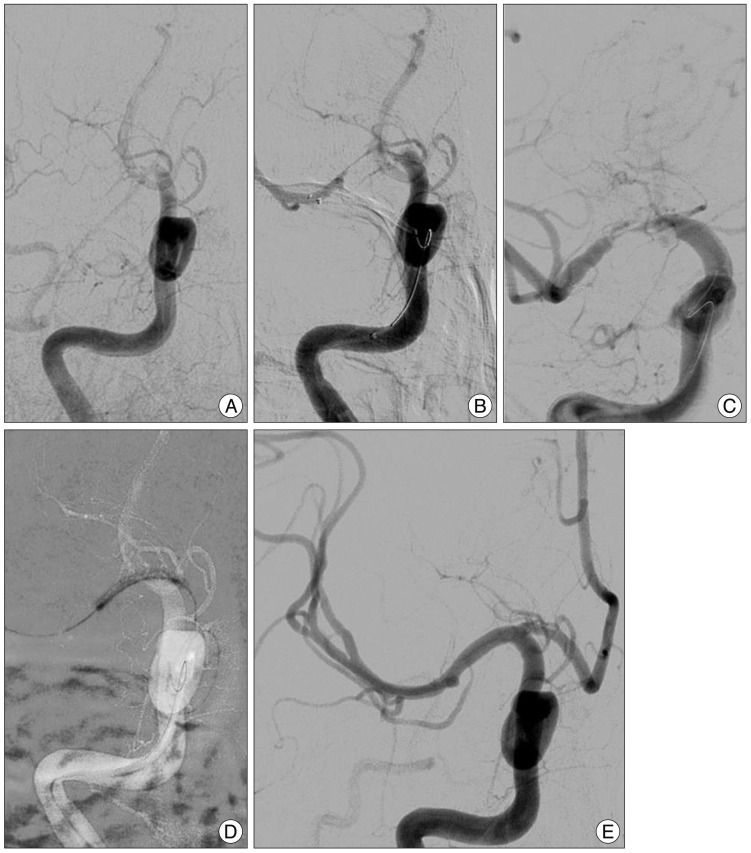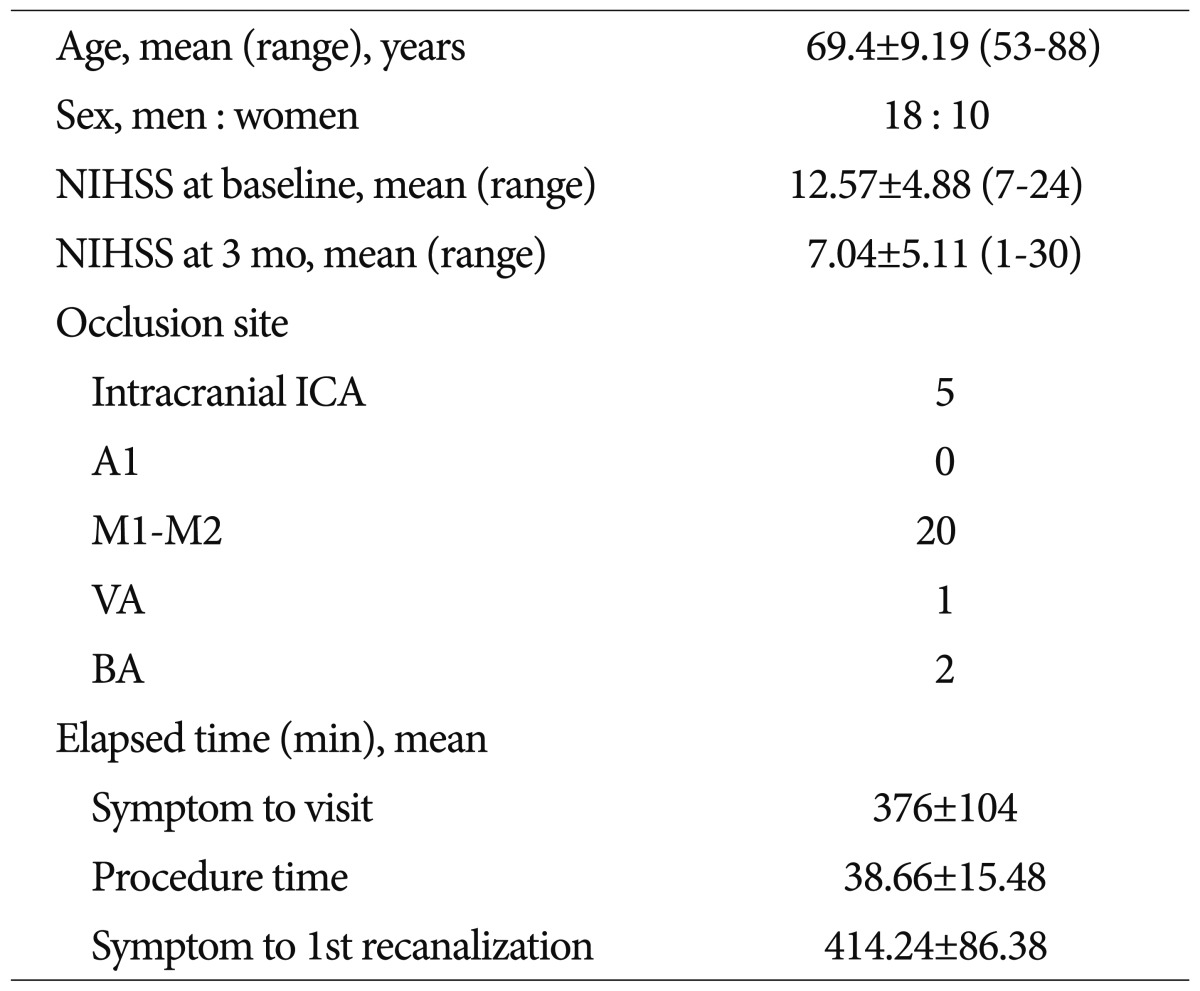1. Arnold M, Nedeltchev K, Mattle HP, Loher TJ, Stepper F, Schroth G, et al. Intra-arterial thrombolysis in 24 consecutive patients with internal carotid artery T occlusions. J Neurol Neurosurg Psychiatry. 2003; 74:739–742. PMID:
12754342.

2. Bose A, Henkes H, Alfke K, Reith W, Mayer TE, Berlis A, et al. The Penumbra System : a mechanical device for the treatment of acute stroke due to thromboembolism. AJNR Am J Neuroradiol. 2008; 29:1409–1413. PMID:
18499798.

3. Brekenfeld C, Remonda L, Nedeltchev K, Arnold M, Mattle HP, Fischer U, et al. Symptomatic intracranial haemorrhage after intra-arterial thrombolysis in acute ischaemic stroke : assessment of 294 patients treated with urokinase. J Neurol Neurosurg Psychiatry. 2007; 78:280–285. PMID:
17308290.

4. Broderick JP, Lu M, Kothari R, Levine SR, Lyden PD, Haley EC, et al. Finding the most powerful measures of the effectiveness of tissue plasminogen activator in the NINDS tPA stroke trial. Stroke. 2000; 31:2335–2341. PMID:
11022060.

5. Castaño C, Dorado L, Guerrero C, Millán M, Gomis M, Perez de la Ossa N, et al. Mechanical thrombectomy with the Solitaire AB device in large artery occlusions of the anterior circulation : a pilot study. Stroke. 2010; 41:1836–1840. PMID:
20538693.

6. Cohen JE, Gomori JM, Leker RR, Moscovici S, Ramirez-Denoriega F, Itshayek E. Recanalization with stent-based mechanical thrombectomy in anterior circulation major ischemic stroke. J Clin Neurosci. 2012; 19:39–43. PMID:
22136733.

7. Eckert B, Koch C, Thomalla G, Kucinski T, Grzyska U, Roether J, et al. Aggressive therapy with intravenous abciximab and intra-arterial rtPA and additional PTA/stenting improves clinical outcome in acute vertebrobasilar occlusion : combined local fibrinolysis and intravenous abciximab in acute vertebrobasilar stroke treatment (FAST) : results of a multicenter study. Stroke. 2005; 36:1160–1165. PMID:
15890988.

8. Flint AC, Duckwiler GR, Budzik RF, Liebeskind DS, Smith WS. MERCI and Multi MERCI Writing Committee. Mechanical thrombectomy of intracranial internal carotid occlusion : pooled results of the MERCI and Multi MERCI Part I trials. Stroke. 2007; 38:1274–1280. PMID:
17332445.

9. Furlan A, Higashida R, Wechsler L, Gent M, Rowley H, Kase C, et al. Intra-arterial prourokinase for acute ischemic stroke. The PROACT II study : a randomized controlled trial. Prolyse in Acute Cerebral Thromboembolism. JAMA. 1999; 282:2003–2011. PMID:
10591382.

10. Furlan AJ. CVA : reducing the risk of a confused vascular analysis. The Feinberg lecture. Stroke. 2000; 31:1451–1456. PMID:
10835471.

11. Gobin YP, Starkman S, Duckwiler GR, Grobelny T, Kidwell CS, Jahan R, et al. MERCI 1 : a phase 1 study of Mechanical Embolus Removal in Cerebral Ischemia. Stroke. 2004; 35:2848–2854. PMID:
15514171.
12. Grunwald IQ, Walter S, Papanagiotou P, Krick C, Hartmann K, Dautermann A, et al. Revascularization in acute ischaemic stroke using the penumbra system : the first single center experience. Eur J Neurol. 2009; 16:1210–1216. PMID:
19659754.

13. Higashida RT, Furlan AJ, Roberts H, Tomsick T, Connors B, Barr J, et al. Trial design and reporting standards for intra-arterial cerebral thrombolysis for acute ischemic stroke. Stroke. 2003; 34:e109–e137. PMID:
12869717.

14. Kase CS, Furlan AJ, Wechsler LR, Higashida RT, Rowley HA, Hart RG, et al. Cerebral hemorrhage after intra-arterial thrombolysis for ischemic stroke : the PROACT II trial. Neurology. 2001; 57:1603–1610. PMID:
11706099.

15. Kim YS, Garami Z, Mikulik R, Molina CA, Alexandrov AV. CLOTBUST Collaborators. Early recanalization rates and clinical outcomes in patients with tandem internal carotid artery/middle cerebral artery occlusion and isolated middle cerebral artery occlusion. Stroke. 2005; 36:869–871. PMID:
15746449.

16. Koh JS, Lee SJ, Ryu CW, Kim HS. Safety and efficacy of mechanical thrombectomy with solitaire stent retrieval for acute ischemic stroke : a systematic review. Neurointervention. 2012; 7:1–9. PMID:
22454778.

17. Kulcsár Z, Bonvin C, Pereira VM, Altrichter S, Yilmaz H, Lövblad KO, et al. Penumbra system : a novel mechanical thrombectomy device for large-vessel occlusions in acute stroke. AJNR Am J Neuroradiol. 2010; 31:628–633. PMID:
20019113.

18. Machi P, Lobotesis K, Maldonado IL, Costalat V, Vendrell JF, Riquelme C, et al. Endovascular treatment of tandem occlusions of the anterior cerebral circulation with solitaire FR thrombectomy system. Initial experience. Eur J Radiol. 2012; 81:3479–3484. PMID:
22386898.

19. Papanagiotou P, Roth C, Walter S, Behnke S, Politi M, Fassbender K, et al. Treatment of acute cerebral artery occlusion with a fully recoverable intracranial stent : a new technique. Circulation. 2010; 121:2605–2606. PMID:
20547941.

20. Park H, Hwang GJ, Jin SC, Jung CK, Bang JS, Han MK, et al. A retrieval thrombectomy technique with the Solitaire stent in a large cerebral artery occlusion. Acta Neurochir (Wien). 2011; 153:1625–1631. PMID:
21479799.

21. Rha JH, Saver JL. The impact of recanalization on ischemic stroke outcome : a meta-analysis. Stroke. 2007; 38:967–973. PMID:
17272772.

22. Saver JL. Number needed to treat estimates incorporating effects over the entire range of clinical outcomes : novel derivation method and application to thrombolytic therapy for acute stroke. Arch Neurol. 2004; 61:1066–1070. PMID:
15262737.
23. Smith WS, Sung G, Saver J, Budzik R, Duckwiler G, Liebeskind DS, et al. Mechanical thrombectomy for acute ischemic stroke : final results of the Multi MERCI trial. Stroke. 2008; 39:1205–1212. PMID:
18309168.
24. Smith WS, Sung G, Starkman S, Saver JL, Kidwell CS, Gobin YP, et al. Safety and efficacy of mechanical embolectomy in acute ischemic stroke : results of the MERCI trial. Stroke. 2005; 36:1432–1438. PMID:
15961709.

25. The National Institute of Neurological Disorders and Stroke rt-PA Stroke Study Group. Tissue plasminogen activator for acute ischemic stroke The National Institute of Neurological Disorders and Stroke rt-PA Stroke Study Group. N Engl J Med. 1995; 333:1581–1587. PMID:
7477192.
26. Tomsick T, Broderick J, Carrozella J, Khatri P, Hill M, Palesch Y, et al. Revascularization results in the Interventional Management of Stroke II trial. AJNR Am J Neuroradiol. 2008; 29:582–587. PMID:
18337393.

27. Wick MC, Klocker J, Jaschke W, Chemelli A. Endovascular popliteal thrombectomy using the self-expanding, retrievable Solitaire recanalization device. J Endovasc Ther. 2012; 19:34–36. PMID:
22313199.

28. Zaidat OO, Suarez JI, Santillan C, Sunshine JL, Tarr RW, Paras VH, et al. Response to intra-arterial and combined intravenous and intra-arterial thrombolytic therapy in patients with distal internal carotid artery occlusion. Stroke. 2002; 33:1821–1826. PMID:
12105360.

29. Zangerle A, Kiechl S, Spiegel M, Furtner M, Knoflach M, Werner P, et al. Recanalization after thrombolysis in stroke patients : predictors and prognostic implications. Neurology. 2007; 68:39–44. PMID:
17200490.






 PDF
PDF ePub
ePub Citation
Citation Print
Print




 XML Download
XML Download